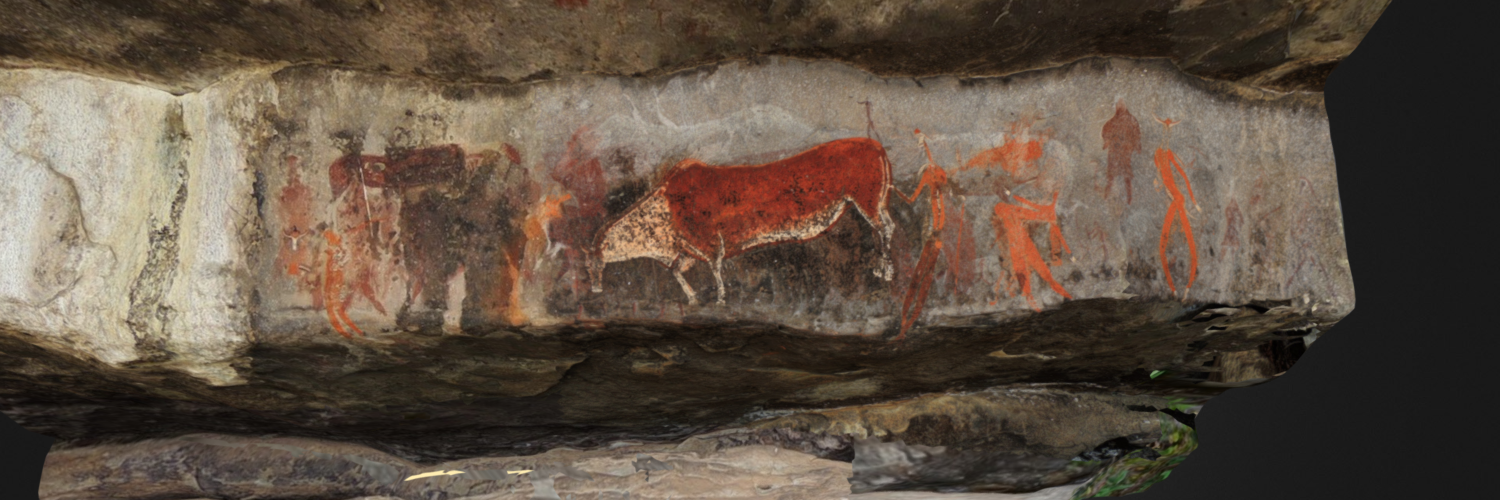Hop on board as we continue our journey Around the World in 80 Models! We began our itinerary at Sketchfab headquarters in New York and are working our way through Europe, Africa, Asia, Oceania, South America, and North America. To catch up on past destinations, check out the rest of the Around the World in 80 Models series.
This week we head down to South Africa, where we will spend a couple of weeks checking out some of their fantastic rock art. The African Conservation Trust takes us to Maloti Drakensberg Park, where we will explore Battle Cave and the Rosetta Stone of Rock Art.
Maloti Drakensberg Park, South Africa: Battle Cave and Rock Art in South Africa
This work was done by the African Conservation Trust (ACT), a non-profit organisation based in South Africa. We started scanning in 2010 when we implemented a project with the University of KwaZulu-Natal to create a digital database of rock art in the Maloti Drakensberg Park (MDP). All our field work is done using the Leica ScanStation C10, and processing with Leica Cyclone, 3DReshaper and Autodesk Memento. One of the challenges with scanning this site was the long walk to get there with our scanner and equipment! Most Drakensberg rock art sites are remote and require steep walks and river crossings. Sketchfab has allowed us to make our scans freely available to everyone, since the aim of our work is to document heritage but also to make that data freely available to the public.
Battle Cave is a beautiful example of Drakensberg rock art located in the Injasuthi section of the Maloti Drakensberg Park (MDP). This splendid battle scene located at the far right of the shelter consists of three clusters of human figures. At first this painting seems to be an obvious depiction of a fight between two rival groups, but as with most San rock art, initial appearances are deceptive and it is often more symbolic. The San painted figures in outstanding detail using feathers, animal hairs or grass as paint brushes. In this model you can see the amazing detail in the figures and you can even see arrows flying through the air.
- Hiking to a rock art site in the Drakensberg
- Scanning the main panel at Battle cave
- Rock art custodian and guide from the local community. To visit one of the open sites you have to be accompanied by a trained custodian. This is to protect the rock art from damage and supports the local community.
- Detail from the paintings
- Scanning the site
- A fascinating panel just left of the battle scene showing half-human half-animal figures. The ‘pointy heads’ are likely a depiction of the feeling of lightheadedness experienced by the Shaman during a trance.
The rock art of the Drakensberg has been regarded as the only tangible record left of the San, who for the past 100 years have been considered an extinct people and culture in South Africa. The San painters used a mixture of red and yellow ochre, charcoal, manganese oxide and clay which was bound together with blood, fat, egg or plant extract. The global significance of their rock art contributed to the listing of the MDP as a UNESCO World Heritage Site in 2000.
The park contains over 600 known rock art sites that date back approximately 4,000 years, the largest and most concentrated group of paintings in Africa south of the Sahara. Unfortunately much of the rock art has been damaged by vandalism, fire, vegetation, and natural weathering. The fragile rock paintings are continuously exposed to the elements and are gradually deteriorating as time passes. As restoration is not possible, it is of the utmost importance to digitally preserve the rock art so that the legacy of the San people will not be lost forever.
Maloti Drakensberg Park, South Africa: Rosetta Stone of Rock Art
This iconic panel was one of the first South African sites to be known in other parts of the world, appearing in the Scientific American in 1915. It has been dubbed the ‘Rosetta Stone of Southern African rock art’ because it was in these paintings that archaeologists first uncovered a vital key to understanding the symbolism of San rock art. Drakensberg rock art was first thought to be simple reproductions of everyday life by a primitive people, but this panel shows mystical images seen by the Shamans (healers) during a state of trance that reveals the complex spiritual beliefs of the San. Click on the annotations to learn more about the paintings.
- Scanning the paintings
- Rock art custodian and guide from the local community. To visit one of the open sites you have to be accompanied by a trained custodian. This is to protect the rock art from damage and supports the local community.
- Rock art damaged by weathering and vandalism. This why we do what we do, to save these amazing sites before they are lost forever.
- A view of the site, showing the location of the Eland Panel and the Rosetta Stone Panel.
- A 3D model of the panel
- An interactive map showing which sites are open for guided tours.
The site is located in the Maloti Drakensberg Park (MDP) World Heritage Site.
To learn more about the African Conservation Trust, visit the ACT heritage website.
To see more of the African Conservation Trust’s models here on Sketchfab, check out their profile.















